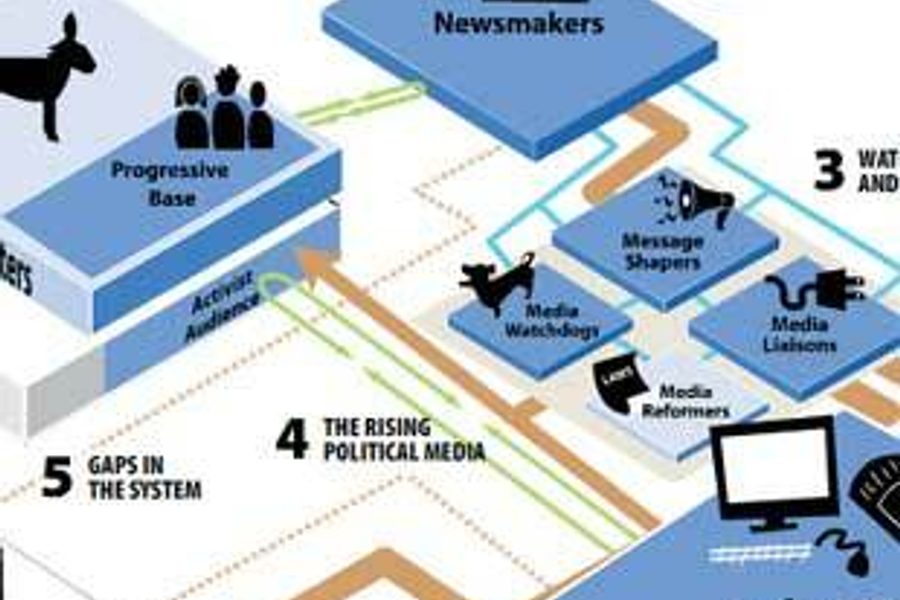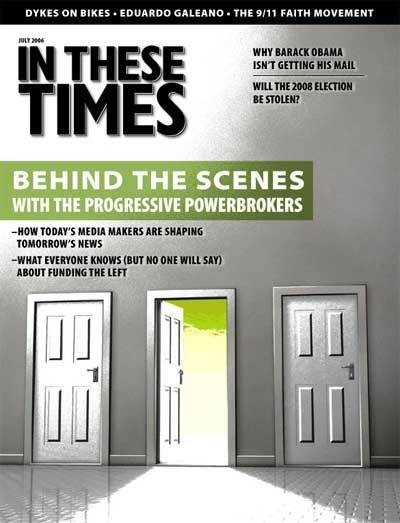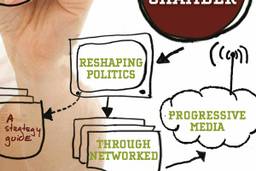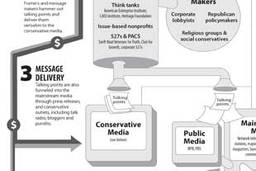Welcome to the Media Revolution
How today’s media makers are shaping tomorrow’s news
Jessica Clark and Tracy Van Slyke

On September 29, 2005, in a conference room on the 17th floor of a Philadelphia office building, blocks away from Independence Hall, members of a newly formed network, The Media Consortium, gathered to reshape the national media landscape.
To a casual observer, the situation may not have looked much different than any other business meeting. Flipboards and sheets of paper filled with scrawling penmanship were scattered across the room. Tables overflowed with laptops, cell phones, Blackberries, notebooks and half-empty cups of coffee that had seen numerous refills throughout the two-day meeting.
By the end of the meeting the consortium members were clustered around an 11 x 17 sheet of printer paper. One by one we added our names to the Declaration of the Independent Media. Among the 25 signatories were editors, publishers and directors of various media organizations including The American Prospect, The Nation, Mother Jones, The Progressive, The Washington Monthly, AlterNet.org, Grist.org, Link TV, Free Speech TV, Air America, New American Media and In These Times.
The declaration reads, in part:
We, the makers and providers of progressive, independent journalism, declare our intent to form among ourselves a new nonprofit association, The Media Consortium. … We believe it is possible and necessary to seize the current moment and change the debate in this country on our terms. Therefore, the mission of The Media Consortium is of vital importance – not just for the furtherance of our individual enterprises, but for the health of American democracy.
While the language lacks the grandeur of “We hold these truths to be self-evident,” the declaration represents a revolutionary shift in the world of progressive media. “We recognized that there were things we had to do together, that we couldn’t do by ourselves. Our future depends on it,” says Steve Katz, project director of The Media Consortium and associate publisher of Mother Jones.
Why should media be a priority, with Iraq in a civil war, living wage jobs continuing to spiral downward and the Earth’s environment heating up? Because media serves as the forum for all political debate. The right has learned to use the media to its political advantage. Now, progressives must reclaim their place in the national conversation.
We documented the beginnings of the progressive media network in our May 9, 2005 issue, “Making Connections.” Here we report on the unprecedented collaborations fostered by this emerging media network in the past year and explore the opportunities and challenges it now faces.
Members of The Media Consortium, who make up a large segment of this network, understand that in order to shift the national debate progressive media will need to break through to a larger audience. The end goal: to develop a sustainable progressive media infrastructure that can inform and influence public opinion, encourage grassroots action and create political change. But to do so media outlets and media-focused organizations need three things: support from each other, investment in core journalistic efforts, and a strategy for moving into new digital media that facilitate rapid response initiatives and audience interaction.
“We’re trying to redefine who we are to reach the audience of the 21st century,” Katz says. “Progressive media is to the progressive audience as classic rock is to the radio audience. We know we can do better and we know people are looking for good journalism and a progressive point of view. We’re also looking at the platforms in which people are getting their information. Technology is changing and we need to change with it.”
Jan Schaffer, a professor of journalism at the University of Maryland, told a conference of editors in October 2004, “The potential of new media is not simply more noise – but information experiences and meaningful interaction – and even, I would suggest, entirely new kinds of civic participation.”
Media is the movement
Reinventing progressive media is an uphill battle. Progressives are competing against a ruthless right-wing media machine and a dominant commercial media sector that has honed audience-distraction tactics.
Many new progressive media projects have arisen in direct response to the dominance of the right’s media apparatus. As Rob Stein, David Brock and Eric Alterman, among others, have documented, right-wing funders and ideologues have over the past three decades created their own successful cadre of media and messaging organizations, from think tanks to magazines to radio and television outlets. They have infiltrated the mainstream media, rallying conservatives across the country.
“What conservatives thus enjoy,” writes Paul Waldman in Being Right is Not Enough: What Progressives Must Learn from Conservative Success, “is a wide-ranging, multimedia apparatus that when tapped will vibrate like a gigantic tuning fork.”
In response to this distortion of the public debate, many media activists have focused on the problems of the mainstream commercial media. After the Telecommunications Act of 1996 gutted regulatory limits on media ownership, policy reform organizations like Free Press and the Center for International Media Action organized public campaigns against media consolidation. Monitoring groups, like Media Matters for America, Fairness and Accuracy in Reporting (FAIR), and Women in Media and News (WIMN) serve as watchdogs, alerting their members and the media to inaccuracies, conservative bias, sexism and racism in both news and entertainment programming.
Booking and distribution organizations like the Institute for Public Accuracy and the Mainstream Media Project act as media liaisons, attempting to funnel progressive activists, academics and pundits into the mainstream media. Most recently, progressive “framing” efforts and think tanks like the Center for American Progress have used their research to shape messages that define and promote progressive values to a wider audience.
Such media activism is crucial to reshaping the country’s media landscape. But pointing out the flaws in the mainstream media is not enough.
Progressive media outlets are critical agents of social change. Progressive magazines and books provide the research and long-range analysis needed to support political movements. Radio and television humanize a story and bring it to a mass audience. And blogs have now begun to serve as a powerful rapid response system.
The Media Consortium provides formal and informal support to progressive media-makers and is distinguished as much by its cross-media approach as it is by its commitment to building a progressive movement.
Despite good intentions, however, such efforts can get complicated. At one of The Media Consortium’s brainstorming sessions, a scrawled question on a flip board summed up what was on the mind of many: “Who’s in, who leads, and who gets $?”
Who’s in, who’s out
Like much of the progressive movement, media organizations have historically developed in isolation or competition with one another. They thrive on debate. Consequently, a unified progressive narrative has not developed. An influential contingent of self-identified progressives maintains that this must change. They argue that fracturing media and activism into single-issue “silos” pulls funding and energy away from the building of a larger progressive media movement.
“An opening now exists, as it hasn’t in a very long time, for the Democrats to be the visionaries,” writes Michael Tomasky, the editor of The American Prospect, in the magazine’s May 3 issue. “To seize this moment, the Democrats need to think differently – to stop focusing on their grab bag of small-bore proposals that so often seek not to offend and that accept conservative terms of debate. And to do that, they need to begin by looking to their history, for in that history there is an idea about liberal governance that amounts to more than the million-little-pieces, interest-group approach to politics that has recently come under deserved scrutiny and that can clearly offer the most compelling progressive response to the radical individualism of the Bush era.”
Such statements set off alarm bells for the groups being dismissed as “special interests.” Too often, progressive writers and pundits believe that because they are “enlightened” about issues such as racism, sexism and everything else, they have the expertise to be the public voices on those issues. Yet this argument misses the fact that communities invested in specific issues often respond best to messages internal to their own culture and communities. This does not mean that media always has to be segregated by cause or audience, but cultural awareness is important when progressives attempt to integrate different voices and perspectives into the movement.
Other media activists resist top-down infrastructure building altogether, finding the project of adopting commercial forms and tactics for their media projects antithetical to their mission of empowering the disenfranchised and critiquing capitalist culture. Instead they advocate teaching these communities to create their own media. “Unless we do that, we’re not going to be shifting power, which is what social justice is about,” says Aliza Dichter of the Center for International Media Action.
Honoring diversity and supporting democratic participation are central to the progressive project. In order to succeed, members of the progressive media network must develop better channels of communication between issue-specific movements and the media outlets attempting to articulate the larger progressive vision.
This is exactly what the right did, argue Jean Hardisty and Deepak Bhargava in a fall 2005 Nation article, “Wrong About the Right.” “There is no monolithic ‘conservative’ movement but rather a plethora of ideologies successfully harnessed together in a grand coalition. The implication for progressives is that we ought to tolerate a diversity of views and think strategically about how to align them to common purpose rather than seek a homogeneity we falsely ascribe to conservatives.”
Models for success
While crucial coordination takes shape, such efforts are hindered by the fact that most progressive media projects remain small and underfunded. Large-scale foundation funding for media projects has historically been funneled to public media such as PBS and NPR, or to issue-oriented media campaigns. In recent years, funders have become enamored with new technology initiatives. Foundations have avoided directly supporting overtly political independent media outlets. The right has no such qualms, understanding that providing general operating support strengthens media outlets, allowing them to invest in circulation, marketing and new technology.
Politically committed funders must work with and support media organizations to develop business models that can succeed in the long run. Progressive media infrastructure cannot exist without media organizations. A table will not stand without legs.
Seeing nonprofits continue to struggle, a new generation of progressive media projects has begun to experiment with private-sector business models, with varying levels of success. Such outlets operate with what funders call a “double bottom line.” The Investors’ Circle, an organization that matches funders and financial institutions with socially responsible projects, explains how this works:
Mainstream media companies operate within both an intensely competitive industry and the unforgiving conventional financial markets. … [but] both philanthropic and private market financial entities are increasingly paying attention to niche media that attend to both the financial bottom line and social impact.
Progressive media outlets have also started looking to their commercial counterparts, like the Washington Post Company, for clues about how to amplify stories. In addition to the flagship newspaper, the corporation owns Newsweek, the Post-Newsweek family of television stations, the CableOne systems that provide Internet services to subscribers in several states, and an online publishing subsidiary, Washingtonpost.Newsweek Interactive, which manages WashingtonPost.com, Newsweek.com, Slate.com and Budget Travel Online. Owning these cross-media properties allows the company to promote products and stories across a variety of platforms, a strategy known as “vertical integration.”
Many critics have noted that such integration involves consolidation that commercializes and dumbs down the media. In the progressive media sector, however, vertical integration operates not through ownership, but through organizing.
By linking up with each other, media outlets can cross-promote, reach new audiences and build momentum around an issue. The battle over network neutrality, detailed in the map on page 25, is one current example of the power of the budding progressive media network. This campaign created a groundswell of coverage around a policy issue that would have otherwise passed unnoticed.
View a special interactive version of the progressive media map discussed in this article.
Similarly, the progressive media network has come together to promote blogger and attorney Glenn Greenwald’s new book, How Would a Patriot Act? This first book by Working Assets Publishing, released in May, represents an experiment in rapid-response publishing and grassroots promotion. Conservative publishers, like Regnery Publishing, have made a mint and generated a wave of “experts” by aggressively promoting their books, like Ramesh Ponnuru’s The Party of Death: The Democrats, the Media, the Courts, and the Disregard for Human Life, to the conservative base via right-wing media. They sidestep the mainstream book reviews and market their books like political campaigns. Marjory G. Ross, Regnery’s publisher, told the Philadelphia Inquirer, “We don’t really care about reviews because we want sparks to fly. That’s much easier on radio and TV than in print.”
Brought to market in just 12 weeks How Would a Patriot Act? hit the top of the Amazon charts before it was even published and debuted on the New York Times bestseller list in early June. The book was pushed by many progressive blogs, but older progressive media, however, are still a bit hesitant to jump into the fray. “It’s been like pulling teeth trying to get progressive media outlets to pay attention to the book,” Greenwald says.
Adopting the integration model, Robert Greenwald, the director of Wal-Mart: The High Cost of Low Price Living, is pioneering a new model for distributing documentary films through grassroots channels. Journalists like Farai Chideya, pundits like Al Franken, comedians like Janeane Garofalo, academics like Juan Cole and politicians like Al Gore have become multimedia masters, spreading their ideas through progressive and commercial print media, radio, online outlets, books, television appearances and speaking engagements.
Collaborations among members of the media network can take many forms. Media outlets with a traditional journalistic mission may prefer to confine their work with other publications to syndication and cross-promotion. More overtly political media projects have already moved to merge content production with grassroots organizing. The YearlyKos conference, which takes place as this issue goes to press, exemplifies this trend. Organized by the readers and diarists at the popular progressive blog, DailyKos, observers have said this could be a watershed moment for the “netroots.”
The next frontier
All stripes of media are attempting to connect with the growing broadband audiences. The change is “happening in every media sector, television, motion, sound media” says Peter Ledyen, director of the think tank New Politics Institute. He identifies the most recent tipping point as September 2005, when news about Apple’s video iPods began to make the rounds. News of this new platform sparked a wave of investment into broadband content like short films and news clips. Ever since, Leyden says, it has been “a headlong, pell-mell, dizzy kind of rush. It’s very exciting and quite scary.”
He notes that progressives have an advantage in this new environment. The majority of the people at the front end of these new technologies have a progressive worldview and inhabit the coastal blue cities and urban hubs. “Companies innovating in this space are often run by out-and-out avowed progressive types,” he says.
Take “The Young Turks,” a trio of liberal radio hosts that can be heard on Sirius Satellite Radio and on the Web. They are pioneering the next frontier of online broadcasting. After a failed attempt to get MSNBC to pick up their radio show as a liberal TV show, the Young Turks went a different route. With the support of investors they bought digital cameras and rented studio space. As the Los Angeles Times reported, “In mid-December, they began streaming their three-hour show every weekday on their website … billing it as the first live Internet talk show,” writes Matea Gold. “In the process, they’ve helped pioneer the rapidly developing field of online programming – from webcasts to video podcasts and vlogs (the video version of a blog) – now delivering content that traditionally would have had to survive the television development season and pass the muster of network executives to find an audience.”
“The Young Turks” are part of an explosion of efforts to bypass network and cable channels and develop progressive content for emerging satellite, dish and digital broadcast platforms. Other efforts include more established broadcasters like LinkTV and Free Speech TV, online projects like PoliticsTV and The Real News, an effort to establish a progressive cable channel.
Traditional media – print, radio and television – are struggling to balance staying true to the tenets of journalism, with reaching new audiences with interactive features and, in some cases, the ideologically aggressive tone that has come to characterize much of the mainstream news environment.
This rapid technological evolution is challenging print publishers. But, as Arianna Huffington writes in a recent blog post on Huffingtonpost.com, “It’s not an either-or proposition. Despite drops in circulation, print magazines are not going the way of the dodo bird (indeed, there are over 5,000 more magazine titles on sale now than there were in 1988) – and the 75,000 new blogs appearing every day won’t be the death knell of Big Media. Instead, if the mainstream media play their cards right, the new media could provide a transfusion of energy, passion, and immediacy that will alter – and ultimately save – them. Provided they keep adapting to the changing technologies – and, more importantly, the changing audience.” The same can be said for the progressive media.
In order to flourish, progressive media makers must understand and pursue this new online audience, as the rise of the political blogosphere attests. Yet even the bloggers must contend with the hegemony of the mainstream media.
In “The Triangle: The Limits of Blog Power” on Salon.com, Peter Daou writes, “Simply put, without the participation of the media and the political establishment, the netroots alone cannot generate the critical mass necessary to alter or create conventional wisdom … That is not to say that blogs can’t be the first to draw attention to an issue, as they often do, but the half-life of an online buzz can be measured in days and weeks, and even when a story has enough netroots momentum to float around for months, it will have little effect on the wider public discourse without the other sides of the triangle in place.”
While progressive bloggers focus on the daily news grind, other progressive media play a different, but equally important, role. Progressive outlets reported on the lies of the Bush administration and the atrocities in Darfur months before these became mainstream news stories. And they chronicled the hidden desperation of poor Americans – long before Katrina, which made Anderson Cooper famous for noticing the “news” that was all around him.
This static triangle of the beltway, the bloggers and the big boys of cable TV will not shift the debate. It will take a vibrant network of progressive media outlets, reporters, artists, grassroots organizers, politicians, researchers, celebrities, activists, think tanks and citizens working in concert.
Connections still to be made
With two and a half years left in the Bush presidency and the mid-term elections looming, progressives have begun developing a network that can elevate progressive ideals and experts into the mainstream, as well as media initiatives that reach critical new audiences. But is that enough? AlterNet Executive Editor Don Hazen noted in a recent article, “The emerging media elements, as feisty and effective as they are, don’t yet add up to an overall media vision and infrastructure. Much of the new progressive media capacity is reactive, lacking the ability to effectively frame a vision for the future.”
In order to shape the news instead of responding to it, progressive organizations and media outlets still need pipelines for moving stories, reporters and experts into each other’s outlets, as well as into agenda-setting media like “Meet the Press.”
While groups like the Institute for Public Accuracy promote progressive experts and academics to the mainstream media, no organizations are doing the same for the independent journalists and analysts. Progressives must develop and fund the next level of infrastructure to accomplish this. One idea worth discussing is the creation of a national progressive booking agency.
It is also time to harness progressive content through a national syndication service that will connect to other media outlets, including campus newspapers, the ethnic media and local opinion pages. Projects such as FeatureWell.com and the Progressive Media Project do place progressive content into mainstream outlets, but this has not been supported on a large scale.
The reporters, pundits and bloggers on the front lines of political debate need to forge stronger ties to the think tanks and organizations that provide the facts and research needed to make a case for progressive change. The Center for American Progress has made great strides in this area, as has the New York-based Drum Major Institute (DMI), which has revamped its operations to focus on communicating its findings to the a wider audience. “We have a saying here,” says Elana Levin, DMI’s director of communications. “If a report wasn’t read, it wasn’t written.” As part of its strategy, DMI requires its fellows to blog, a perfect example of bridging old and new communication models.
All of these strategies must work in tandem, connecting existing institutions with the evolving 21st century audience, thereby reaching people who previously only had access to mainstream news.
“What’s changed in the last five years is that the people who used to be called the audience are now co-participants in creating the news,” says Micah Sifry, executive editor of the Personal Democracy Forum, a Web site that explores the intersection of technology and politics. “Progressive media as a whole has become profoundly more small-d democratic, open and participatory.”
And all that gives progressive media the chance to find larger audiences than ever before. “The playing field has been leveled between so-called mainstream and so-called alternative media,” says Sifry. “I recently heard Amy Goodman brag that her ‘Democracy Now!’ podcast has as many subscribers on iTunes as Tim Russert’s ‘Meet the Press.’ Surely that tells us that the old notion of creating an ‘alternative’ media in opposition to the ‘mainstream’ has become meaningless. At a time when anyone can find any article or report from almost any news outlet in the world directly and instantaneously, it makes little sense to marginalize ourselves as ‘alternative.’”
It’s important to stay abreast of new media opportunities, but adopting and shifting into these new forms won’t be enough. In order to break through the din, members of the progressive media network will have to produce reporting and political entertainment that is surprising, immediate, factual and nuanced, using all of the tools at its disposal: collaboration, activism, aesthetics, humor, and a deep understanding of the power that progressive values and history have to inspire.
Bill Moyers recently told a meeting of public broadcasters, “One reason we get such pale and unquestioning journalism in America is that skepticism and irreverence toward the prerogatives of power and privilege are exactly what corporate media moguls don’t want from the journalists who work for them.”
Skepticism and irreverence, along with a commitment to the values of free speech, social justice, environmental conservation and equal opportunities for all, are what the 21st century audience is hungry for. It’s time for progressive media makers to seize the moment.
View a special interactive version of the progressive media map discussed in this article.
Tracy Van Slyke, a former publisher of In These Times, is project director of The Media Consortium and co-editor of buildtheecho.net. Clark and Van Slyke are the co-authors of Beyond the Echo Chamber: Reshaping Politics Through Networked Progressive Media (2010, New Press)







